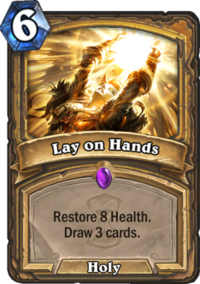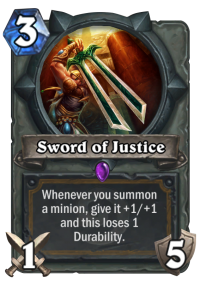Of the many Year of the Phoenix announcements earlier this week, the aggressive revamp of the Priest class’ evergreen set is perhaps the most interesting from a design implications perspective. Such a change – much like the introduction of a tenth class – would have been unimaginable in the past. It was a long overdue adjustment: the difference between the classes’ evergreen cards has led to a baked-in power imbalance in Standard, one that was further exacerbated by nerfs and Hall of Fame rotations. Removing recurrent strategies with Northshire Cleric and Divine Spirit is one thing – adding long-awaited Classic AoE is another. Though Priest is the class whose woes were the most obvious, there’s a good argument to be made that Paladin would warrant a similar overhaul, a class whose core cards enabled an exhaustion-based control strategy that is no longer viable whatsoever in the game.
I Heal My Opponent and Emote

Though you don’t want to nail a class to a specific archetype entirely, it makes sense that they gravitate towards a certain playstyle. Priest has always been built up as a control class first and foremost, with tools that were more than competitive in the Classic days, even with the gaping hole where a strong AoE card should have been in their arsenal. Indirect value generation with their hero power coupled with many strong removal options set them up quite well, though Warrior and Paladin were in many ways better suited to control gameplans even back then (the former with a better anti-aggro toolkit and the latter thanks to the superior value generation with their hero power).
The combo burn finisher strategies were never viable without strong expansion support, meaning the rotation of Holy Fire, Shadowform and Prophet Velen (plus Auchenai Soulpriest and the change to Holy Smite”]) doesn’t significantly impact the Priest gameplay experience in Standard under normal circumstances. To summarize, the cards which rotated out either failed to support the class’ core identity or superseded any such strategies (think Divine Spirit+Inner Fire). With their standard removal-based late-game approach rendered useless due to the increasing resource generation in the game, Priest kept falling behind the curve, always scrambling to catch up to the rest thanks to their considerably weaker evergreen sets.
Turns out, Paladin is very much in the same situation.
Put Your Faith in the Light

As I like to mention at every opportunity, Classic’s Healadin remains my favorite Hearthstone deck to this day. It was a Control deck on the very edge of the spectrum, crushing opponents of the same archetype but with real anti-aggro weaknesses which kept it a niche option. Its goal was to match its thirty cards with yours, neutralize them on a one-on-one basis and eventually win off the back of the Silver Hand Recruits. Back in those days, Paladin’s hero power itself was enough to serve as the source of inevitability in grindy control mirrors. Just math it out against Warrior: eventually, they will have to use a card to deal with your swarm of 1/1s while their armor is rendered useless when you have the last card standing. That trickle of tiny knights had pretty much the same effect as Jades did much later in the game’s history.
As new sets arrived, this archetype was pushed towards a midrange direction with cards like Zombie Chow, Shielded Minibot and Muster for Battle, with a curve that eventually culminated in TGT’s infamous Secret Paladin. By then, the tempo options were so strong (not to mention Druid’s omnipresent burst potential from hand with the pre-nerf Force of Nature + Savage Roar combo) that you couldn’t reliably stall out the game. Once Standard rotations entered the picture, it was the resource generation aspect that made such strategies untenable. Initially, N'Zoth, The Corruptor was the big problem card, which also highlighted Paladin’s unique struggles with Deathrattles. With finicky board clears and no dedicated hard removal in their evergreen toolkit, the class’ control options, much like Priest’s, couldn’t keep up with the demands of the metagame. It’s no surprise then that the popular Paladin decks of the last few years all relied on strong synergies from newly printed sets and tilted in a more aggressive direction – again, much like Priest. It tells you all you need to know about the state of Paladin that Tirion Fordring, once widely considered the best card in the game from a value standpoint, simply hasn’t seen play for years.
Another Revamp?

Yet another way in which Priest and Paladin are alike is the hodge-podge nature of their Classic and Basic sets with little in terms of unifying theme. The class only got Secrets at a very late stage of development instead of Rogues, and it shows, with very little gameplay application in a Standard environment under normal circumstances despite taking up a huge chunk of their Classic set. Paladin also has to cope with grossly outpaced healing tools like Holy Light and Guardian of Kings, which were actually relevant parts of Healadin back in the day but are practically useless in today’s cutthroat environment with incredible damage output potential. Blessed Champion and Avenging Wrath also never fulfilled the promised fantasy (though the latter did see some play in Even Paladin for a short while).
The list doesn’t end there. Ultimately, the class’s control gameplan was always about removing threats in an inefficient manner. Humility and Aldor Peacekeeper didn’t directly kill big minions, and Equality also cannot get rid of a large board by itself. Now, Consecration is just a strictly worse version of the new Holy Nova, and it’s not like dealing 2 damage on turn 4 is even a relevant anti-aggro play nowadays. If you don’t factor in the Classic days, you’ll find that only a small portion of Paladin’s evergreen cards have any relevance in Constructed and the class needs entire archetypes built from the ground up via expansions to have relevance. Again, much like Priest.
Of course, suggesting specific cards would veer dangerously close to r/customhearthstone territory and would basically be a pointless and futile exercise. Nevertheless, a comparative look at the Priest card changes and replacements serves as a good starting point to highlight the same sort of roles that a revamped Paladin evergreen set would fulfill in an ideal world:
- Rotate to Hall of Fame because the fantasy is never fulfilled: Blessed Champion, Avenging Wrath (+ possibly Sword of Justice)
- Rotate to Hall of Fame because they produce degenerate gameplay that isn’t line with the core class identity: Holy Wrath
- Replace due to low power level: Secret package, Holy Light, Humility, Hand of Protection (possibly a revamp of Righteousness)
- Buff due to low power level: Consecration (3 mana or maybe some extra effect at 4)
Not much would be left – but as Arthas said once, this entire evergreen set must be purged.

To me even shaman must be reworked, his cards are always nerfed (fire totem, rock bite, ecc.), overload card are pretty meh for the cost/overload (with few exception) and last but not least it’s the only class with a random hero power on 2020.
Secret paladin from saviors of uldum/doom in the tomb era was my favorite deck in HS ever. I’m conflicted on them giving up on paladin secrets. But I’m all for more Evergreen makeovers.
As someone who almost only plays paladin and priest I fully agree with you. In the next rotation paladin will be close to the worst class in the game, while in wild it will still be practically the best class. Paladin’s evergreen cards are pretty much garbage and the only evergreen cards that ever see play are really truesilver, consecration, and tirion. I think paladin even needed more of a rework than priest.
You, Sir, must be a very enduring character if you only play those two classes. I salute you (honestly).